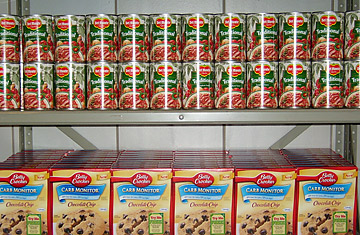
The offerings at the food bank at Michigan State University include college favorites like chocolate chip cookie mix.
College students have always scraped by on less-than-nutritious food — ramen noodles, pizza, Diet Coke — but as the price of grocery shopping climbs, more of them are struggling to find their next meal. With the economy tanking and a 5% increase in food prices this year, the highest in nearly two decades, college students are increasingly turning to a new kind of financial aid: food pantries.
"At first, I was like, 'Oh, man, I hope no one sees me here, it's embarrassing,'" says Jessica Makolin, 21, an advertising major who will graduate from Michigan State in December. Makolin says she eventually grew more comfortable patronizing Michigan State's Student Food Bank, the only food bank in the nation run for students by students. The Lansing organization experienced a nearly 15% increase in traffic this past school year, with the number of visits topping out at more than 4,000 in 2007-2008. Students' need for food assistance is on the rise around the country. For example, at Texas Women's University in Denton, the food pantry for students noted a sharp increase in customers during the summer session; meanwhile, a Seattle food bank near the University of Washington has seen about a 25% increase in students' visits compared to the previous calendar year, and demand for the food assistance program at the Community College of Denver has doubled in the last year.
At Michigan, where the food bank is supported by charitable donations and hosted in the health center cafeteria every two weeks, the offerings include staples —such as bread, canned vegetables and soup — in addition to a rotating list of college student favorites, including microwave popcorn and baking mixes. Each pick-up day 10 or 15 student volunteers help package food, stock shelves and serve customers. They conduct interviews to see how much food to give out — if a customer has a family to support, he or she gets more — but almost never turn someone away. "Someone who is not on a tight budget is probably not going to go through the hassle," says Kristin Moretto, 34, an education graduate student and the director of the food bank.
The past couple of years, Moretto says, have seen a growing number of undergraduate customers. Makolin, for one, says she started going because of the economy and a tough situation at home. She drives home to Ann Arbor every weekend, which takes an hour each way, to help her mother care for her father, who has Parkinson's disease. Even with a paid internship, Makolin says, it's tough to pay for ever-pricier food on top of an increasingly expensive commute as well as her own housing and utilities bills. "My dollar box of mac and cheese isn't a dollar anymore," she says. Like many food bank patrons, Makolin says the food bank has enabled her to stay in school.
Despite the undergrad uptick, Moretto says about 60% of the Michigan patrons are graduate students, who often have families of their own to support. Jana Simmons, 26, a Ph.D candidate in biochemistry, started going to the food bank last summer shortly after her daughter was born. Simmons' husband is a certified teacher, but in the state's struggling economy, she says, he hasn't been able to find a classroom job in over four years, working as a roofer instead. Simmons' stipend, meanwhile, "isn't enough to live on," she says. Paying for day-care and diapers on top of a commute that was already growing more expensive as gas prices rose, she adds, "puts a big strain on the budget." The food bank's offerings include applesauce, one of her 21-month-old's favorites.
No matter how much it may help, though, using a food bank is an adjustment for many students like Makolin. Back in 2004, when she was a senior in high school, Makolin was named Ann Arbor News Young Citizen of the Year — in large part because she volunteered at multiple food banks. "I find somewhat ironic that I am now on the other side of the counter," she says.
